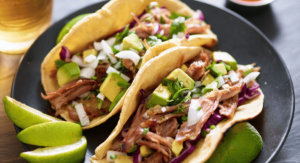In traditional Mexican cooking, grilling, known as “asar,” refers to the method of cooking food directly over an open flame or on a grill. This technique typically involves the direct application of heat to the ingredients, imparting smoky flavors and charred notes to the food.
Grilling differs from other Mexican cooking methods like stewing or sautéing as it involves cooking food directly over an open flame, imparting a distinct smokiness and charred taste to the dishes. This technique highlights simplicity, relying on the natural flavors of the ingredients and the addition of smoky nuances from the grilling process.
What is the Culinary Significance of Grilling?
Grilling holds significant importance in Mexican culinary traditions due to its historical roots and its ability to infuse dishes with unique smoky flavors. It’s a technique deeply intertwined with outdoor gatherings, celebrations, and communal cooking, symbolizing both culinary prowess and cultural heritage.
Grilling contributes immensely to the flavors and textures of Mexican dishes by creating a delightful contrast of smoky, charred exteriors and tender interiors. It adds depth to meats, vegetables, and fruits, elevating their natural tastes while infusing them with an enticing smokiness.
What Ingredients are Suitable for Grilling?
In Mexican cuisine, various meats like beef, pork, chicken, and seafood, alongside vegetables such as bell peppers, onions, and corn, are commonly grilled. Fruits like pineapples and cactus paddles (“nopales”) are also popular choices for grilling.
Specific cuts of meat such as arrachera (skirt steak), carne asada (thinly sliced beef), and al pastor (marinated pork) are traditional favorites for grilling in Mexico. Additionally, vegetables like poblano peppers and cactus paddles, as well as fruits like pineapples, often grace the grill, imparting distinctive flavors to Mexican dishes.
What are the Best Practices for Grilling?
Key Steps in Preparing Ingredients before Grilling
Before grilling in Mexican recipes, preparing ingredients involves marination with spices, herbs, and acidic elements like lime juice or vinegar. Additionally, ensuring meats are at room temperature and patting vegetables dry aids in achieving optimal grill marks and flavors.
Marination or Seasoning in Mexican Cuisine
Marination or seasoning plays a significant role in Mexican cuisine before grilling. It not only imparts flavors but also tenderizes meats and allows for the infusion of diverse spices, enhancing the overall taste profile of grilled dishes.
Grill Temperature Control
Maintaining the right temperature while grilling Mexican dishes is crucial to achieve the desired results. Controlling the heat ensures proper cooking without burning or undercooking, especially for meats that require precise doneness.
Preferred Grilling Methods
Traditional Mexican recipes often employ direct grilling over charcoal, wood, or gas flames. This direct heat method imparts smokiness and char while preserving the natural flavors of the ingredients.
How to Infuse Flavors in Grilling
Flavors are infused into dishes during grilling in Mexican cooking through the use of marinades, basting sauces, and the natural aromas from the grilling process. Ingredients like meats, vegetables, and fruits absorb smoky flavors from the grill, enhancing their taste.
Specific Seasoning Techniques and Marinades
Marinades in Mexican cuisine for grilling often include combinations of spices like cumin, paprika, chili powder, garlic, and citrus juices such as lime or orange. These marinades or dry rubs are applied before grilling to impart depth and complexity to the dishes. Additionally, basting with sauces like adobo or salsa can enhance flavors during the grilling process.
How to Grill (Asar) in Mexican Recipes
Prominent Mexican Dishes Prepared via Grilling
- Carne Asada: This iconic dish features marinated beef grilled over an open flame, often served as tacos, in burritos, or as a main dish with accompaniments like rice and beans.
- Tacos al Pastor: Marinated pork is stacked on a vertical rotisserie, reminiscent of Middle Eastern shawarma, then thinly sliced and grilled. It’s commonly served in tacos with pineapple and onions.
- Tlayudas: Large tortillas are grilled and topped with various ingredients like refried beans, meats, Oaxacan cheese, and vegetables, then cooked again on the grill until crispy.
Step-by-Step Guidance on Grilling in These Dishes
For Carne Asada, the beef is marinated with lime juice, garlic, cumin, and other spices, then grilled over high heat until charred yet tender. It’s sliced and served with tortillas and salsa.
In Tacos al Pastor, marinated pork is stacked on a spit with layers of pineapple and onions, slowly grilled, and shaved off for serving in tacos.
Tlayudas involve grilling the large tortilla until slightly crispy, adding toppings, and grilling again to meld flavors and create a crispy base.
Regional Variations and Specialties
Grilling techniques and ingredients vary across regions in Mexico. Coastal regions often emphasize seafood grilling, while inland areas focus more on meats and indigenous ingredients. Different regions use distinct marinades, seasonings, and grilling methods, influenced by local flavors and traditions.
In Baja California, fish tacos are a specialty, featuring grilled fish fillets served in tortillas with fresh toppings and creamy sauces. In Oaxaca, the use of wood-fired grills is prevalent, influencing dishes like grilled meats served with mole sauce or grilled tlayudas topped with local ingredients like chapulines (grasshoppers).
Various regions have unique styles of grilling; for example, in Northern Mexico, open-fire grilling of beef, called “asado,” is prominent, while Southern regions may use traditional earthen pits known as “barbacoa” to slow-cook meats underground.
Common Errors to Avoid When Grilling
- Not Preheating the Grill: Failing to preheat the grill adequately can result in sticking and uneven cooking.
- Overcrowding the Grill: Crowding the grill prevents proper airflow and can lead to steaming instead of grilling, affecting the flavors and grill marks.
- Lack of Oil or Marinade on Ingredients: Insufficient oil or marinade on ingredients can cause sticking and dryness, impacting the overall taste and texture.
Prevention and Rectification of Mistakes
- Preheating and Oiling the Grill: Ensure the grill is preheated for several minutes and properly oiled before adding ingredients to prevent sticking. Brushing the grill grates with oil or marinating ingredients adequately helps avoid this issue.
- Properly Spacing Ingredients: Avoid overcrowding the grill by arranging ingredients with enough space between them, allowing even cooking and preventing steaming.
- Adequate Oil or Marinade: Ensure ingredients are properly coated with oil or marinade to prevent dryness and sticking. Reapply oil or marinade during cooking if necessary to keep the ingredients moist.
Troubleshooting Grilling Issues
If ingredients are sticking to the grill during cooking, try gently loosening them with a spatula or tongs. Additionally, brushing the grill grates with oil or using an oil-soaked paper towel held with tongs can help prevent sticking.
If a dish is undercooked, move it to a cooler part of the grill or lower the heat and continue cooking until done without direct heat. To salvage over-charred food, trim off excessively charred parts and adjust the cooking time or heat for the remaining cooking duration to avoid further charring. Additionally, consider finishing the dish in an oven to ensure even cooking without excessive charring.
Essential Equipment for Grilling
Below is a detailed list of essential grilling items. Ensuring you have a supply of these should ensure that the grilling experience goes smoothly.
- Grill: Choose from various types like gas, charcoal, pellet, or electric grills, considering personal preference and convenience. Gas grills offer quick heating, while charcoal grills provide smokiness. Pellet grills offer versatility, and electric grills are suitable for indoor use.
- Grill Utensils: Essential tools include long-handled tongs, spatula, grill brush, meat thermometer, and basting brush for safe handling, flipping, cleaning, and checking food temperatures.
- Grill Thermometer: Consider a grill thermometer for monitoring temperature accuracy, especially for charcoal grills where temperature control is essential.
- Grill Accessories: Grill baskets, skewers, smoker boxes, and grill mats add versatility to your grilling experience, allowing for easy cooking of delicate items, kebabs, smoking, and preventing small ingredients from falling through grates.
Tips for Selecting the Right Equipment
- Consider Grill Size: Choose a grill size suitable for your needs, considering the frequency of use and the number of people you typically cook for.
- Material Quality: Opt for durable materials like stainless steel or cast iron for longevity and easy maintenance. Ensure sturdy construction and good craftsmanship in the grill’s build.
- Heat Control Features: Look for grills with features like adjustable vents, multiple burners, or temperature control settings for precise heat management, crucial for different cooking methods.
- Portability and Storage: Consider portability if you plan to move or store the grill frequently. Compact designs or wheels for easy movement can be advantageous.
- Budget and Brand Reliability: Set a budget and research reputable brands known for quality, warranties, and customer support to ensure a reliable and satisfying grilling experience.
- Additional Features: Explore additional features such as side burners, warming racks, or integrated storage options based on your preferences and cooking needs.
Selecting the right equipment ensures an enjoyable and efficient grilling experience, allowing you to create delicious Mexican dishes and explore diverse flavors with confidence.
Conclusion
Grilling, known as “asar,” stands as a cornerstone cooking method, deeply rooted in Mexican culinary heritage. From sizzling meats to charred vegetables and smoky-infused dishes, the grill imparts an array of vibrant flavors that elevate classic Mexican recipes.
Understanding the nuances of grilling involves not only selecting the right equipment but also embracing essential techniques like marination, temperature control, and seasoning. Avoiding common pitfalls such as sticking or uneven cooking ensures a gratifying grilling experience.
Moreover, the versatility of grilling extends beyond the kitchen, inviting communal gatherings, celebrations, and outdoor feasts, echoing the social and cultural significance ingrained in Mexican traditions.
With a careful selection of equipment, and adherence to best practices, one can embark on a flavorful journey through Mexican grilling, creating memorable dishes that celebrate Mexican cuisine. Whether it’s the sizzle of carne asada or the aroma of grilled vegetables, the grill remains an essential tool for unlocking the authentic tastes of Mexico.





